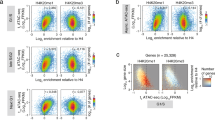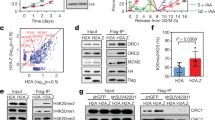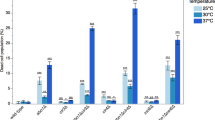Abstract
Histone methylation is important in regulating chromatin structure and function. In budding yeast, methylation of histone H3 at Lys4 (H3-K4) is associated with active transcription and is enriched at the 5′ regions of transcribed genes. Here we identify a novel budding yeast JmjC domain–containing H3-K4 demethylase, Jhd2p, that antagonizes the trimethyl modification state and contributes to regulation of telomeric silencing.
This is a preview of subscription content, access via your institution
Access options
Subscribe to this journal
Receive 12 print issues and online access
$189.00 per year
only $15.75 per issue
Buy this article
- Purchase on Springer Link
- Instant access to full article PDF
Prices may be subject to local taxes which are calculated during checkout


Similar content being viewed by others
References
Martin, C. & Zhang, Y. Nat. Rev. Mol. Cell Biol. 6, 838–849 (2005).
Martin, D.G. et al. Mol. Cell. Biol. 26, 7871–7879 (2006).
Wysocka, J. et al. Nature 442, 86–90 (2006).
Bannister, A.J. et al. Nature 410, 120–124 (2001).
Lachner, M., O'Carroll, D., Rea, S., Mechtler, K. & Jenuwein, T. Nature 410, 116–120 (2001).
Millar, C.B. & Grunstein, M. Nat. Rev. Mol. Cell Biol. 7, 657–666 (2006).
Ng, H.H., Robert, F., Young, R.A. & Struhl, K. Mol. Cell 11, 709–719 (2003).
Zhang, L., Schroeder, S., Fong, N. & Bentley, D.L. EMBO J. 24, 2379–2390 (2005).
Katan-Khaykovich, Y. & Struhl, K. EMBO J. 24, 2138–2149 (2005).
Klose, R.J., Kallin, E.M. & Zhang, Y. Nat. Rev. Genet. 7, 715–727 (2006).
Tsukada, Y. et al. Nature 439, 811–816 (2006).
Xiao, B. et al. Nature 421, 652–656 (2003).
Miller, T. et al. Proc. Natl. Acad. Sci. USA 98, 12902–12907 (2001).
Nislow, C., Ray, E. & Pillus, L. Mol. Biol. Cell 8, 2421–2436 (1997).
Schlichter, A. & Cairns, B.R. EMBO J. 24, 1222–1231 (2005).
Krogan, N.J. et al. J. Biol. Chem. 277, 10753–10755 (2002).
Mueller, J.E., Canze, M. & Bryk, M. Genetics 173, 557–567 (2006).
Nagy, P.L., Griesenbeck, J., Kornberg, R.D. & Cleary, M.L. Proc. Natl. Acad. Sci. USA 99, 90–94 (2002).
Smith, J.S. et al. Proc. Natl. Acad. Sci. USA 97, 6658–6663 (2000).
Shi, Y. et al. Cell 119, 941–953 (2004).
Acknowledgements
We thank J. Lieb (University of North Carolina, Chapel Hill), H. Dolhman (University of North Carolina, Chapel Hill) and C. Brandl (University of Western Ontario) for providing plasmids, B. Strahl (University of North Carolina, Chapel Hill) for providing the BY4741, set2Δ, spt4Δ, rtf1Δ, snf2Δ, spt7Δ, htz1Δ and sir2Δ strains, and E. Turnbull for critical reading of the manuscript. This work was supported by US National Institutes of Health grant GM68804 (to Y.Z.). Y.Z. is an Investigator of the Howard Hughes Medical Institute. R.J.K. is supported by the Canadian Institutes of Health Research.
Author information
Authors and Affiliations
Contributions
G.L., R.J.K., K.E.G. and Y.Z. designed the experiments. G.L., R.J.K. and K.E.G. carried out the experiments. R.J.K. and Y.Z. wrote the manuscript.
Corresponding author
Ethics declarations
Competing interests
The authors declare no competing financial interests.
Supplementary information
Supplementary Table 1
Phenotype analysis in the jhd2Δ strain. (PDF 101 kb)
Rights and permissions
About this article
Cite this article
Liang, G., Klose, R., Gardner, K. et al. Yeast Jhd2p is a histone H3 Lys4 trimethyl demethylase. Nat Struct Mol Biol 14, 243–245 (2007). https://doi.org/10.1038/nsmb1204
Received:
Accepted:
Published:
Issue Date:
DOI: https://doi.org/10.1038/nsmb1204
This article is cited by
-
Diverse and dynamic forms of gene regulation by the S. cerevisiae histone methyltransferase Set1
Current Genetics (2023)
-
Chromatin regulatory genes differentially interact in networks to facilitate distinct GAL1 activity and noise profiles
Current Genetics (2021)
-
H3K4 methylation at active genes mitigates transcription-replication conflicts during replication stress
Nature Communications (2020)
-
Counteracting H3K4 methylation modulators Set1 and Jhd2 co-regulate chromatin dynamics and gene transcription
Nature Communications (2016)
-
Yeast histone H3 lysine 4 demethylase Jhd2 regulates mitotic ribosomal DNA condensation
BMC Biology (2014)



